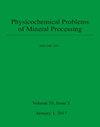Recovery of base and precious metals from scrap TV boards using zig-zag air separator
IF 1.2
4区 工程技术
Q4 CHEMISTRY, PHYSICAL
引用次数: 0
Abstract
Waste of Electrical and Electronic Equipments (WEEE) is one of the fastest growing waste streams in the world. The treatment of WEEE with high content of precious metals (Au in particular) has received the most attention due to their high economic potential. The development of simple, environmentally friendly and cost-effective methods for the recovery of metals from “low-value” WEEE (e.g., <100 g/t Au) is important from the circular economy perspective. In this study, the separation of base (Cu) and precious (Ag) metals from scrap TV boards (STVBs) by using a zig-zag air separator was investigated. Size-reduced scrap STVBs (-1 mm) were subjected to separation tests after the removal of the fine fraction (-0.1 mm). The sized scrap material (-1 +0.1 mm) was determined to have a metal content of 15.4% Cu, 47 g/t Ag and 0.05% Fe, with no gold. In the air separation tests, the effect of air flow rate (4-16 m/s) on the recovery of metals was studied. Increasing the air flow rate resulted in low metal recoveries with concurrent high metal grades in the concentrate. Separation efficiency (%) calculations showed that the most efficient separation is obtained at the highest air flow rate of 16 m/s. At this flow rate, 15.4% of the material was recovered in the concentrate which contains 62.3% Cu and 198 g/t Ag with recoveries of 63.3% Cu and 73.9% Ag. The findings indicated that zig-zag air separators can be used to obtain a metal-rich fraction under suitable conditions of the flow regime.用锯齿形空气分离器从废电视板中回收贱金属和贵金属
电气和电子设备废弃物(WEEE)是世界上增长最快的废物流之一。具有高含量贵金属(特别是Au)的WEEE的处理由于其高经济潜力而受到最广泛的关注。从循环经济的角度来看,开发简单、环保且具有成本效益的方法从“低价值”废电器电子产品(例如,<100 g/t Au)中回收金属是重要的。在本研究中,研究了使用Z字形空气分离器从废电视板(STVBs)中分离贱金属(Cu)和贵金属(Ag)的方法。在去除细小部分(-0.1 mm)后,对尺寸减小的废料STVB(-1 mm)进行分离测试。经测定,经上浆的废料(-1+0.1mm)的金属含量为15.4%Cu、47g/t Ag和0.05%Fe,不含金。在空气分离试验中,研究了空气流速(4-16m/s)对金属回收率的影响。增加空气流速导致金属回收率低,同时精矿中的金属品位高。分离效率(%)计算表明,在16m/s的最高空气流速下获得了最有效的分离。在该流速下,在含有62.3%Cu和198 g/t Ag的精矿中回收了15.4%的材料,回收率为63.3%Cu和73.9%Ag。研究结果表明,在合适的流动条件下,Z字形空气分离器可用于获得富含金属的馏分。
本文章由计算机程序翻译,如有差异,请以英文原文为准。
求助全文
约1分钟内获得全文
求助全文
来源期刊

Physicochemical Problems of Mineral Processing
CHEMISTRY, PHYSICAL-MINING & MINERAL PROCESSING
自引率
6.70%
发文量
99
期刊介绍:
Physicochemical Problems of Mineral Processing is an international, open access journal which covers theoretical approaches and their practical applications in all aspects of mineral processing and extractive metallurgy.
Criteria for publication in the Physicochemical Problems of Mineral Processing journal are novelty, quality and current interest. Manuscripts which only make routine use of minor extensions to well established methodologies are not appropriate for the journal.
Topics of interest
Analytical techniques and applied mineralogy
Computer applications
Comminution, classification and sorting
Froth flotation
Solid-liquid separation
Gravity concentration
Magnetic and electric separation
Hydro and biohydrometallurgy
Extractive metallurgy
Recycling and mineral wastes
Environmental aspects of mineral processing
and other mineral processing related subjects.
 求助内容:
求助内容: 应助结果提醒方式:
应助结果提醒方式:


